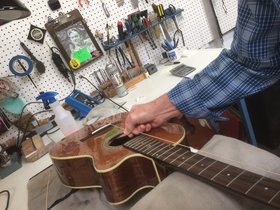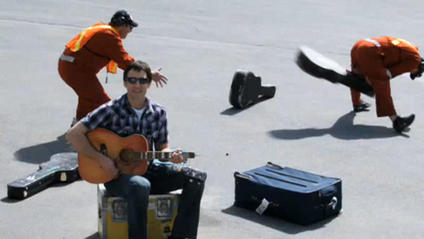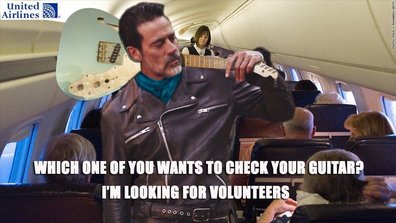 Lately, I have been using a method that I read that Jimi Hendrix used to stretch his strings. Originally, I was using it for Strat's with tremolo bridges, where any little tip can be useful to help with tuning problems. Now, I've found that it can help with stability on all instruments with new strings. Place the string in/through to bridge and secure. Holding the guitar to keep it from moving (I was using my left hand on the headstock in the photo) pull the string, starting at the bridge, while slowly moving down the string toward the other end until you reach the end. Do this several times for each string before you attach to the tuner and tune up. You may want to use gloves. Hendrix believed that this was a better method than stretching the strings while tuning, as the winds on the strings can be difficult to initially loosen while tuning and this is more likely to happen while playing. You will still need to do some stretching while tuning in order to get a good seating at the bridge and tuners.
1 Comment
5/11/2017 2 Comments Keith's Travel Tips I have seen a lot. Broken headstocks, side and top cracks, broken pots, crushed and cracked finishes. This month, I will offer some tips to help prevent damage in transit, as well as some personal experience and a tip on how to get your instrument on board.
1. Most electric guitars and basses can go on board as a carry on in a gig bag, but if you must check your instrument, be sure it is in a good hard case and firmly packed. You don't want any movement inside the case. Pack all open areas with bubble-wrap, t-shirts or towels, or newspaper. Shipping guidelines apply here, if you're familiar with that. Take your picks accessories out of the case and put them in your regular luggage. 2. Loosen the strings. Just a quarter turn is fine. If you slack them all the way, you may find your neck in need of adjustment, when you reach your destination. 3. Get a humidifier. The Humitar by Music Nomad and Planet Waves Humidipak, are good ones. 4. if you have an expensive or valued instrument, consider Travel insurance. Choose a provider that includes loss or damage to valuables. 5. Lastly, a trick I have used on longer flights with a gig bag, is to fashion a wire hanger into the zippered headstock area of the bag, and place a dark suit-bag cover over the case. Walk on and hang it in the closet as you enter, or place it on top of luggage in the overhead. It's amazing how attitudes can change when the idea of a musical instrument is changed to clothing. Ramble On! 5/9/2017 0 Comments Travling With Your InstrumentTravel Season is coming up, and we have tons of tips for traveling with your instrument! Moreover, we also have a large selection of guitars and cases designed specifically for portability, should you want to rock out on your vacay.We've all seen how the airlines treat their paying customers, so imagine what those scoundrels do to your luggage...especially checked guitars. If you have any doubts to the validity of this observation, we have posted a link to the viral video, "United Breaks Guitars", so you can hear (and laugh) about the dangers of checking a fine musical instrument. Luckily, laws were passed during the Obama administration to protect musicians flying with musical instruments. Below are some important excerpts from the FAA regulation as well as a link to relevant page from the Department of Transportation. Know these rules and stand up for your right to travel with an instrument- maybe Unite Airlines wants to buy your next piece of gear via an in or out of court settlement?PART 251: CARRIAGE OF MUSICAL INSTRUMENTS
§ 251.3 Small Musical Instruments as Carry-on Baggage Each covered carrier shall permit a passenger to carry a violin, guitar, or other small musical instrument in the aircraft cabin, without charging the passenger a fee in addition to any standard fee that carrier may require for comparable carry-on baggage, if (a) the instrument can be stowed safely in a suitable baggage compartment in the aircraft cabin or under a passenger seat, in accordance with the requirements for carriage of carry-on baggage or cargo established by the FAA; and (b) there is space for such stowage at the time the passenger boards the aircraft. § 251.4 Large Musical Instruments as Carry-on Baggage Each covered carrier shall permit a passenger to carry a musical instrument that is too large to meet the requirements of section 251.3 in the aircraft cabin, without charging the passenger a fee in addition to the cost of an additional ticket described in subparagraph (e), if (a) the instrument is contained in a case or covered so as to avoid injury to other passengers; (b) the weight of the instrument, including the case or covering, does not exceed 165 pounds or the applicable weight restrictions for the aircraft; (c) the instrument can be stowed in accordance with the requirements for carriage of carry-on baggage or cargo established by the FAA; (d) neither the instrument nor the case contains any object not otherwise permitted to be carried in an aircraft cabin because of a law or regulation of the United States; and (e) the passenger wishing to carry the instrument in the aircraft cabin has purchased an additional seat to accommodate the instrument. https://www.transportation.gov/airconsumer/air-travel-musical-instruments |
Keith's BlogWith over 30 years of experience, Keith has some of the most exhaustive knowledge on guitars you'll find. This is his way of sharing that with you. Archives
May 2017
Categories |
|
Hours:
M-F 10:00am-6:00pm Sat 10:00am-5:00pm Closed Sundays |
Keith Holland Guitars
16905 Roberts Road Los Gatos, CA 95032 408-395-0767 (c) 2024, Keith Holland Guitars |



 RSS Feed
RSS Feed